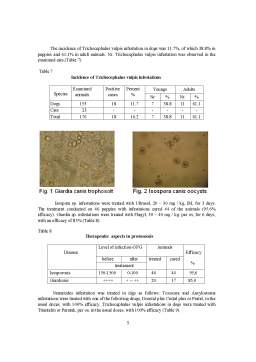Extras din referat
Abstract
The investigations were carried out on a number of 153 dogs and 23 cats from different breeds and ages with a diarrhoea syndrome after a long therapy with antibiotics. Faecal examinations point out infestations with species of protozoa and nematodes correlated with age of animals. Infestations with Isospora sp. were diagnosed in 49.5 % from examined dogs and in 30.4 % from cats registered only in puppies.
Incidence of infestations with Giardia sp. were recorded in 15.6 % dogs from which 83.3 % in puppies and 26.08 % in young cat s. The incidence of infestation with Toxocara canis was 28.7 % in dogs from which 81,8 % in puppies and with Toxocara cati 21.7 % in cats from which 60 % in young cats. Infestations with Ancylostomidae where diagnosed in 18.3 % dogs from which 53.5 % in puppies and 8.6 % in young cats. Infestations with Trichocephalus where registered only in dogs with an incidence of 11.7% from which 61.1 % in adults.
The control of infestations with Isospora sp. was carried out with Ultrasol 20 -30mg/Kg i.m. for 3 days running with 96 % efficacy. Infestations with Giardia sp. where carried out with Flagyl administrated orally for 6 days running with 30 -40mg/Kg registered 85 % efficacy. The control of infestations with nematodes was carried out with usual antihelminthics and registered an entirely efficacy after 10 days.
Key words – protozoas, nematodes, dogs, cats, incidence, therapy.
Introduction
The diarrhoeic syndrome in pets is a frequent disorder observed mainly in young animals (6). The treatment uses a range of antibiotics but the cure is not always 100% because the syndrome’s aetiology may also involve parasitic agents (protozoa and helminths). The determination of the polyfactorial aetiology of the diarrhoeic syndrome requires the identification of the endoparasites species in laboratory. Minnaarn W.N. et al. (8) investigated 164 pet dogs and reported 88% incidence of infestation with Ancylostoma caninum, 36% with Toxocara canis, 9% with Toxascaris leonina and 6% with Trichocephalus vulpis. The authors mentioned the zoonotic potential of these nematoda species. Horejs R., Kondela B.(5) reported a 53.2% incidence of infestation with Giardia in puppets aged 6-12 weeks, 3.4% in adult male dogs and 7% in bitches. O Lorcain P. (7) investigated 350 dogs and 81 cats and reported Ascaridae infection in 82.6% of the puppies aged 3-6 months and in 42% of the young cats. Gonenc A. şi col.(3) used Drontal plus in Ascaridae infections in dogs and reported 100% efficacy.
Material and methods
The investigations were conducted within the clinic of the Faculty of Veterinary Medicine, Spiru Haret University, during February 2006 – June 2007, on 153 dogs and 23 cats of various breeds and ages. The animals displayed a persistent diarrhoeic syndrome after long-term medication with antibiotics. The laboratory investigations were conducted by direct examination of the coprologic samples, using warm saline to detect Giardia trophosoits. We also used Willis and Mc. Master ovohelminthoscopic flotation techniques. The incidence of endoparasite infestations was determined by age category.
Treatment of Isospora infestations was done with Ultrasol, 20 – 30 mg /kg, IM, for 3 consecutive days. Giardia infestations were treated with Flagyl, 30 – 40 mg/kg. per os, for 6 days. Toxocarosis and ancylostomosis were treated with Drontal plus, Cestal plus or Pratel, per os, in usual doses.Trichocephalus vulpis infestations were treated with Triantelm or Paratak, per os, in usual doses.
Results and discussions
The coproscopic revealed infestations with protozoa and nematodes correlated with pet’s age. Table 1 displays the incidence of Isospora sp., infestations showing 76 positive cases (49.6 %) in the examined dogs, 100 % in the puppies. Only 7 positive cases (30.4 %) were detected in cats, all in the young felines.(Table 1)
Table 1
Incidence of Isospora sp. infestations
Species
Examined
animals Positive
cases Percentage Youngs Adults
Nr. % Nr. %
Dogs 153 76 49.6 76 100 - -
Cats 23 7 30.4 7 100 - -
Total 176 83 47.1 83
100
- -
Mitchell S.M. et al.(9) conducted in 2007 experiments of Beagle bitches aged 6 – 8 weeks infested with 5 x 104 Isospora canis oocysts and observed the start of the syndrome 9 – 11 days after infestation, with a patience of 7 – 18 days. The authors concluded that Isospora canis may be the main cause for the diarrhoeic syndrome in puppies.
Papazahariadon M. et al. (10) observed in 2007 a 3.9 % incidence of the Isospora sp. infestation in the coprologic examination of 281 puppies.
Of the 76 dogs infested with Isospora canis, in 67 cases (88.1 %) the infestations occurred in puppies aged 1 – 3 months and in 9 cases (11.8 %) the infestations occurred at the age of 4 – 6 months. In kittens, on 7 positive cases, in 5 animals (71.4 %) the infestations were diagnosed at the age of de 1 – 3 months and in 2 cases (28.5 %) in cats 4 – 6old. (Table 2).
Preview document
Conținut arhivă zip
- Incidenta si Terapia in Sindromul Diareic cu Etiologie Parazitara la Caini si Pisici.doc















